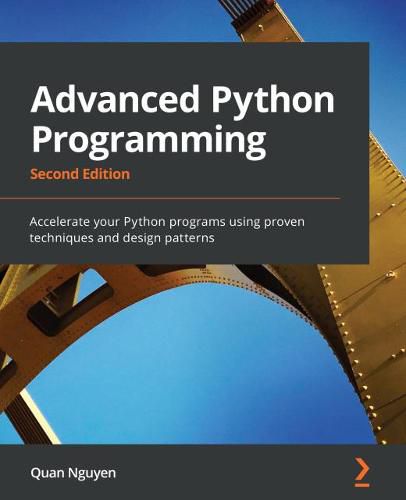Readings Newsletter
Become a Readings Member to make your shopping experience even easier.
Sign in or sign up for free!
You’re not far away from qualifying for FREE standard shipping within Australia
You’ve qualified for FREE standard shipping within Australia
The cart is loading…






This title is printed to order. This book may have been self-published. If so, we cannot guarantee the quality of the content. In the main most books will have gone through the editing process however some may not. We therefore suggest that you be aware of this before ordering this book. If in doubt check either the author or publisher’s details as we are unable to accept any returns unless they are faulty. Please contact us if you have any questions.
Write fast, robust, and highly reusable applications using Python’s internal optimization, state-of-the-art performance-benchmarking tools, and cutting-edge libraries
Key Features
Benchmark, profile, and accelerate Python programs using optimization tools Scale applications to multiple processors with concurrent programming Make applications robust and reusable using effective design patterns
Book DescriptionPython’s powerful capabilities for implementing robust and efficient programs make it one of the most sought-after programming languages.
In this book, you’ll explore the tools that allow you to improve performance and take your Python programs to the next level.
This book starts by examining the built-in as well as external libraries that streamline tasks in the development cycle, such as benchmarking, profiling, and optimizing. You’ll then get to grips with using specialized tools such as dedicated libraries and compilers to increase your performance at number-crunching tasks, including training machine learning models.
The book covers concurrency, a major solution to making programs more efficient and scalable, and various concurrent programming techniques such as multithreading, multiprocessing, and asynchronous programming.
You’ll also understand the common problems that cause undesirable behavior in concurrent programs.
Finally, you’ll work with a wide range of design patterns, including creational, structural, and behavioral patterns that enable you to tackle complex design and architecture challenges, making your programs more robust and maintainable.
By the end of the book, you’ll be exposed to a wide range of advanced functionalities in Python and be equipped with the practical knowledge needed to apply them to your use cases.
What you will learn
Write efficient numerical code with NumPy, pandas, and Xarray Use Cython and Numba to achieve native performance Find bottlenecks in your Python code using profilers Optimize your machine learning models with JAX Implement multithreaded, multiprocessing, and asynchronous programs Solve common problems in concurrent programming, such as deadlocks Tackle architecture challenges with design patterns
Who this book is forThis book is for intermediate to experienced Python programmers who are looking to scale up their applications in a systematic and robust manner. Programmers from a range of backgrounds will find this book useful, including software engineers, scientific programmers, and software architects.
$9.00 standard shipping within Australia
FREE standard shipping within Australia for orders over $100.00
Express & International shipping calculated at checkout
Stock availability can be subject to change without notice. We recommend calling the shop or contacting our online team to check availability of low stock items. Please see our Shopping Online page for more details.
This title is printed to order. This book may have been self-published. If so, we cannot guarantee the quality of the content. In the main most books will have gone through the editing process however some may not. We therefore suggest that you be aware of this before ordering this book. If in doubt check either the author or publisher’s details as we are unable to accept any returns unless they are faulty. Please contact us if you have any questions.
Write fast, robust, and highly reusable applications using Python’s internal optimization, state-of-the-art performance-benchmarking tools, and cutting-edge libraries
Key Features
Benchmark, profile, and accelerate Python programs using optimization tools Scale applications to multiple processors with concurrent programming Make applications robust and reusable using effective design patterns
Book DescriptionPython’s powerful capabilities for implementing robust and efficient programs make it one of the most sought-after programming languages.
In this book, you’ll explore the tools that allow you to improve performance and take your Python programs to the next level.
This book starts by examining the built-in as well as external libraries that streamline tasks in the development cycle, such as benchmarking, profiling, and optimizing. You’ll then get to grips with using specialized tools such as dedicated libraries and compilers to increase your performance at number-crunching tasks, including training machine learning models.
The book covers concurrency, a major solution to making programs more efficient and scalable, and various concurrent programming techniques such as multithreading, multiprocessing, and asynchronous programming.
You’ll also understand the common problems that cause undesirable behavior in concurrent programs.
Finally, you’ll work with a wide range of design patterns, including creational, structural, and behavioral patterns that enable you to tackle complex design and architecture challenges, making your programs more robust and maintainable.
By the end of the book, you’ll be exposed to a wide range of advanced functionalities in Python and be equipped with the practical knowledge needed to apply them to your use cases.
What you will learn
Write efficient numerical code with NumPy, pandas, and Xarray Use Cython and Numba to achieve native performance Find bottlenecks in your Python code using profilers Optimize your machine learning models with JAX Implement multithreaded, multiprocessing, and asynchronous programs Solve common problems in concurrent programming, such as deadlocks Tackle architecture challenges with design patterns
Who this book is forThis book is for intermediate to experienced Python programmers who are looking to scale up their applications in a systematic and robust manner. Programmers from a range of backgrounds will find this book useful, including software engineers, scientific programmers, and software architects.